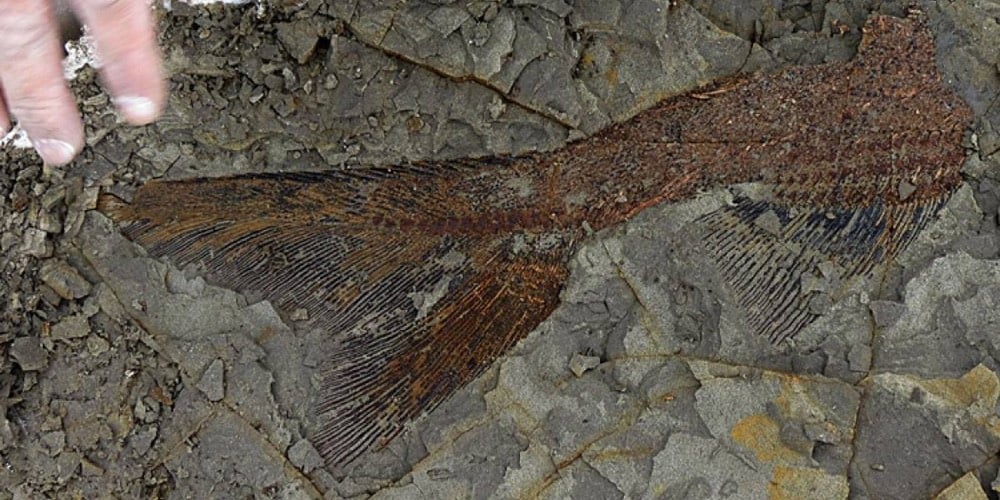The Day the Dinosaurs Died
It’s only Monday, but I’m confident this will be my favorite read of the week. Since 2012, paleontologist Robert DePalma has been excavating a site in North Dakota that he thinks is “an incredible and unprecedented discovery”. What’s potentially so special about this site? Fossils from dinosaurs and other animals from thousands of years before the asteroid impact are very hard to come by, leading some to believe that dinosaurs died out before the impact, not because of it. DePalma believes the site preserves, as if in amber, the day, the precise and exact day (and perhaps even the exact hour), that the massive asteroid believed to have caused the extinction of the dinosaurs hit the Earth 65 million years ago.
As DePalma carefully excavated the upper layers, he began uncovering an extraordinary array of fossils, exceedingly delicate but marvellously well preserved. “There’s amazing plant material in there, all interlaced and interlocked,” he recalled. “There are logjams of wood, fish pressed against cypress — tree root bundles, tree trunks smeared with amber.” Most fossils end up being squashed flat by the pressure of the overlying stone, but here everything was three-dimensional, including the fish, having been encased in sediment all at once, which acted as a support. “You see skin, you see dorsal fins literally sticking straight up in the sediments, species new to science,” he said. As he dug, the momentousness of what he had come across slowly dawned on him. If the site was what he hoped, he had made the most important paleontological discovery of the new century.
The type of evidence present at the site is almost too good to believe:
He noted that every fish he’d found in the site had died with its mouth open, which may indicate that the fish had been gasping as they suffocated in the sediment-laden water.
“Most died in a vertical position in the sediment, didn’t even tip over on their sides,” he said. “And they weren’t scavenged, because whatever would have dug them up afterward was probably gone.”

Clues from the growth stages of animals and pollen found at the site might even point to what season it was when the asteroid struck…DePalma’s current guess is in autumn. And then there’s this, about a burrow that DePalma discovered:
“Any Cretaceous mammal burrow is incredibly rare,” he said. “But this one is impossible — it’s dug right through the KT boundary.” Perhaps, he said, the mammal survived the impact and the flood, burrowed into the mud to escape the freezing darkness, then died. “It may have been born in the Cretaceous and died in the Paleocene,” he said.
A scientific paper is forthcoming this week. I couldn’t find it online, but this piece in Science says that it’s generating some discussion and controversy already.
“Outcrops like [this] are the reasons many of us are drawn to geology,” says David Kring, a geologist at the Lunar and Planetary Institute in Houston, Texas, who wasn’t a member of the research team. “Those few meters of rock record the wrath of the Chicxulub impact and the devastation it caused.” But not everyone has fully embraced the find, perhaps in part because it was first announced to the world last week in an article in The New Yorker. The paper, in the Proceedings of the National Academy of Sciences (PNAS), does not include all the scientific claims mentioned in The New Yorker story, including that numerous dinosaurs as well as fish were buried at the site.
“I hope this is all legit-I’m just not 100% convinced yet,” says Thomas Tobin, a geologist at the University of Alabama in Tuscaloosa. Tobin says the PNAS paper is densely packed with detail from paleontology, sedimentology, geochemistry, and more. “No one is an expert on all of those subjects,” he says, so it’s going to take a few months for the research community to digest the findings and evaluate whether they support such extraordinary conclusions.
I’m eager to follow the progress of this story as more of the results are released and analyzed by the scientific community.
Update: The BBC has made a documentary narrated by David Attenborough about the Tanis site and the discoveries that have been made there so far. There’s evidence that they’ve discovered fragments of the actual asteroid impactor.
The sturgeon and paddlefish in this fossil tangle are key. They have small particles stuck in their gills. These are the spherules of molten rock kicked out from the impact that then fell back across the planet. The fish would have breathed in the particles as they entered the river.
The spherules have been linked chemically and by radiometric dating to the Mexican impact location, and in two of the particles recovered from preserved tree resin there are also tiny inclusions that imply an extra-terrestrial origin.
“When we noticed there were inclusions within these little glass spherules, we chemically analysed them at the Diamond X-ray synchrotron near Oxford,” explains Prof Phil Manning, who is Mr DePalma’s PhD supervisor at Manchester.
“We were able to pull apart the chemistry and identify the composition of that material. All the evidence, all of the chemical data, from that study suggests strongly that we’re looking at a piece of the impactor; of the asteroid that ended it for the dinosaurs.”
The program will air on BBC on April 15 and sometime later this year on PBS.





Stay Connected